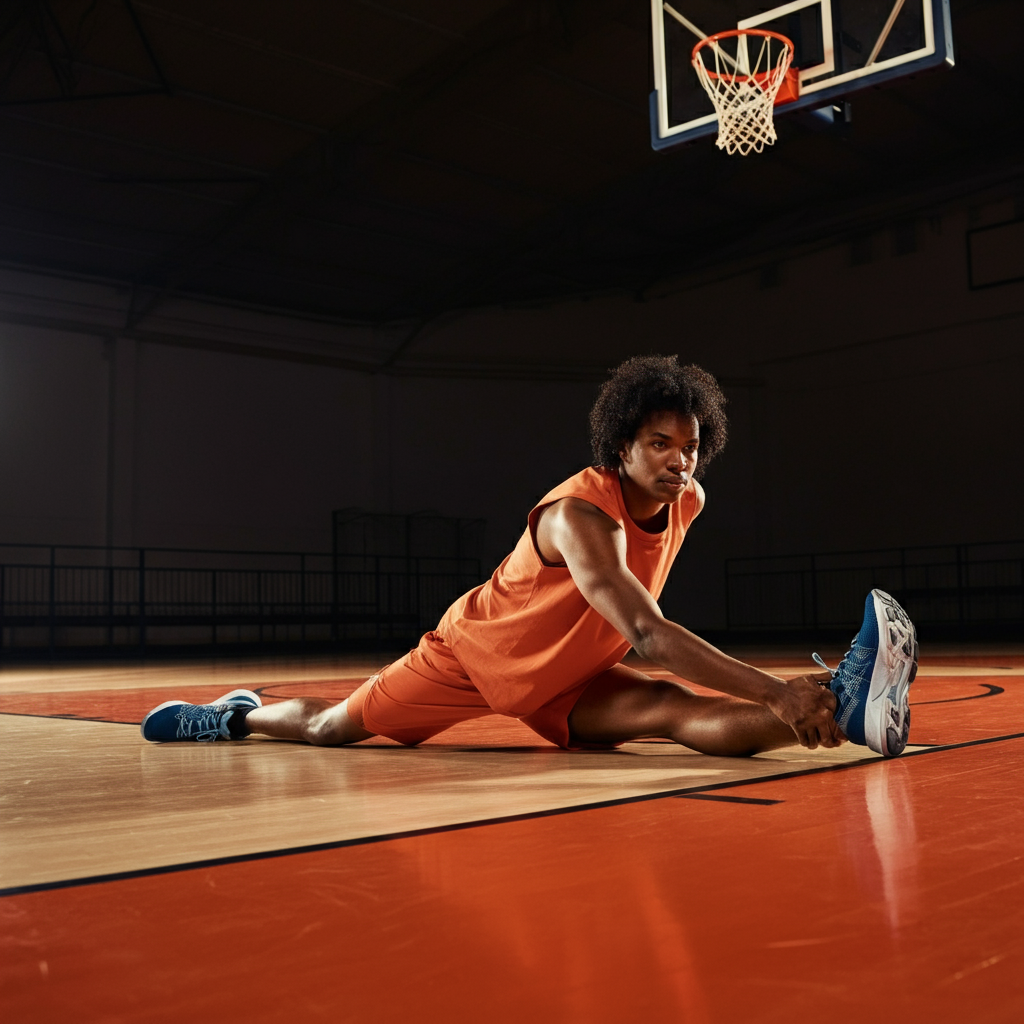
Introduction
Basketball players must move dynamically across the floor, jump with explosive force, and maintain their agility for extended periods of time, making it one of the most demanding sports. However, there is a significant chance of injury and muscular strain with such strenuous physical activity. It is a game-changer to include appropriate basketball stretches in your regimen. The significance of stretching, the difference between dynamic and static stretches, a list of the top basketball stretches, and their advantages for performance and injury prevention are all covered in this extensive book.

Why Stretching Is Essential for Basketball Players
The muscles used by basketball players are crucial for their rapid bursts of power, speed, and agility. Muscles can become taut without stretching, which decreases their flexibility and raises the possibility of strain or injury. This is why stretching is essential:
Enhances Performance
By increasing your range of motion, stretching enables you to perform defensive slides, jump shots, and sprints more effectively. More explosive leaps and quicker direction changes are the results of increased flexibility in muscles like the hamstrings, quadriceps, and hip flexors.
Reduces Injuries
Basketball’s high-impact motions frequently strain tendons, muscles, and joints. By conditioning these areas, stretching lowers the risk of sprains, rips, and strains.
Improves Recovery
Stretching after a practice or game helps loosen up tense muscles. It speeds up muscle regeneration by increasing blood circulation, which eliminates toxins.
Enhances Longevity
Basketball puts a lot of strain on the body. Athletes can extend their playing careers by maintaining a regular stretching regimen, which keeps muscles and joints healthy.
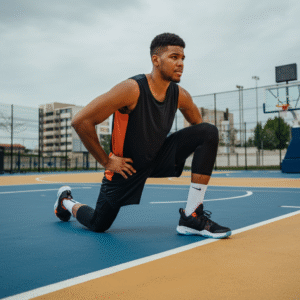
Dynamic vs Static Basketball Stretches
Not every stretch is made equally. Strategic usage of both static and dynamic basketball stretches is most beneficial for basketball players. Below is an explanation of each type and how it fits into your regimen.
What Are Dynamic Stretches?
The purpose of dynamic stretches is to get your body ready for activity. These dynamic exercises aim to warm up muscles, raise heart rate, and enhance mobility by simulating the moves you’ll make on the court.
When to Use Dynamic Stretches:
- Before games or practice.
- During warm-ups to ensure muscles are ready for intense movements.
Key Benefits:
- Improves muscle elasticity.
- Boosts blood flow, increasing oxygen delivery to muscles.
- Prepares the nervous system for quick reflexes.
What Are Static Stretches?
Static stretching entails maintaining a posture for a predetermined amount of time, typically 15 to 30 seconds. When the body is already warm, this method works best for muscle lengthening.
When to Use Static Stretches:
- After games or practice to cool down.
- During recovery days to improve flexibility.
Key Benefits:
- Loosens tight muscles.
- Helps de-stress after high-intensity activity.
- Prevents delayed onset muscle soreness (DOMS).
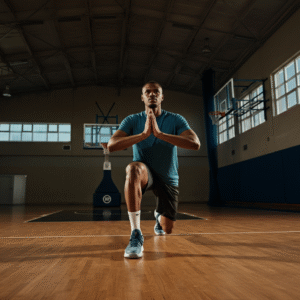
Top Basketball Stretches to Incorporate into Your Routine
Incorporate both dynamic and static stretches into your basketball pre- and post-game routines to enhance your performance and lower your chance of injury. A comprehensive list of efficient basketball stretches can be found below.
Dynamic Basketball Stretches (Warm-Up)
1. High Knees
Target Muscles: Hip flexors, calves, and glutes
High knees help elevate the heart rate while preparing the leg muscles for activity.
- Jog forward while driving your knees up to waist level.
- Swing your arms as you move for balance.
- Continue for 30 seconds.
2. Butt Kickers
Target Muscles: Quadriceps
This stretch activates your quads and helps loosen tight thigh muscles.
- Jog forward while kicking your heels towards your glutes.
- Keep the motion controlled and steady.
- Perform for 30 seconds.
3. Walking Lunges
Target Muscles: Quads, hamstrings, hip flexors, glutes
- Take a large step forward, bending both knees to form a 90-degree angle.
- Push through the front leg and advance with the other leg.
- Perform this for 10 repetitions on each side.
4. Arm Circles
Target Muscles: Shoulders, upper back
Basketball requires quick shooting and passing movements, making shoulder flexibility essential.
- Extend your arms out to the sides.
- Make small circles moving forward for 15 seconds; then reverse for 15 seconds.
5. Carioca (Sideways Shuffle)
Target Muscles: Hip abductors, obliques, calves
- Step laterally, crossing one leg in front of the other.
- Repeat while moving side to side across the court.
6. Straight-Leg Kicks (Frankenstein March)
Target Muscles: Hamstrings and calves
- Kick your legs straight ahead while keeping them stiff.
- Reach for your toes with the opposite hand.
- Repeat for 10 kicks each leg.
7. Ankle Hops
Target Muscles: Calves, Achilles tendon
- Jump lightly using just the balls of your feet.
- Move forward slightly with each hop, keeping the knees soft.
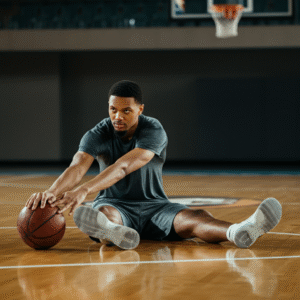
Static Basketball Stretches (Cool-Down)
1. Standing Quad Stretch
Target Muscles: Quadriceps
- Stand upright and grab your left foot with your left hand.
- Pull gently until you feel a stretch in the front of your thigh.
- Hold for 20–30 seconds, then switch legs.
2. Forward Fold
Target Muscles: Hamstrings and lower back
- Stand with feet hip-width apart.
- Hinge at the hips and reach for your toes.
- Hold for 30 seconds.
3. Butterfly Stretch
Target Muscles: Hips, inner thighs
- Sit with your feet pressed together.
- Push your knees down with your elbows for a deeper stretch.
- Hold for 30 seconds.
4. Figure Four Stretch
Target Muscles: Glutes, hips
- Lie on your back with one ankle over the opposite knee.
- Pull the bottom leg towards you until you feel a stretch.
- Hold for 20–30 seconds, then switch sides.
5. Downward Dog
Target Muscles: Calves, hamstrings, shoulders
- Start in a push-up position.
- Push your hips up and back, creating a triangle with your body.
- Hold for 20 seconds.
6. Calf Stretch
Target Muscles: Calves
- Stand with your hands against a wall.
- Extend one leg back, keeping the heel on the ground.
- Hold for 20–30 seconds, then switch legs.
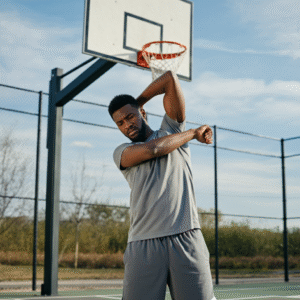
Tips for an Effective Basketball Stretching Routine
- Be Consistent: Make stretching a non-negotiable part of your training.
- Don’t Rush: Hold each stretch for the intended time to get the most benefit.
- Customise: Focus on stretches that target areas where you feel tightness.
- Breath Control: Always breathe deeply to make the basketball stretches more effective.
- Warm-Up First: Avoid static stretches on cold muscles, as this can lead to strain.
Expert Insights on Basketball Stretching
Dynamic stretching is recommended before a game by trainers and sports medicine specialists since research shows that it improves muscular performance. Dynamic stretches, as opposed to static or no stretching before a game, dramatically increased athletes’ vertical jumps, according to a study published in The Journal of Strength and Conditioning Research.
Static stretches combined with foam rolling are recommended for muscle rehabilitation in order to lessen post-game pain. In order to maximise flexibility, trainers often advise incorporating proprioceptive neuromuscular facilitation (PNF) stretching into recuperation sessions.
The Synergy Between Strength and Flexibility
Strength and conditioning training should be complemented by stretching. In addition to improving performance on the court, strong, flexible muscles also act as a protective barrier against potential injuries. For a more comprehensive basketball fitness regimen, combine your basketball stretches with strength-building activities like squats, deadlifts, and plyometrics.
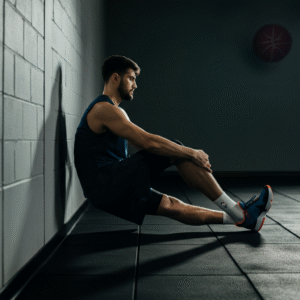
Final Thoughts
Basketball players must stretch; it’s not a choice. Your flexibility, stamina, and ability to withstand injuries will all increase if you combine dynamic basketball stretches to get your body moving before games with static basketball stretches to calm down and recuperate. Start incorporating these basketball stretches into your practice right now to see how they improve your performance.
Stretching regularly and specifically will help you play better and harder while protecting your body from the strain of this intense sport.





Leave a Reply